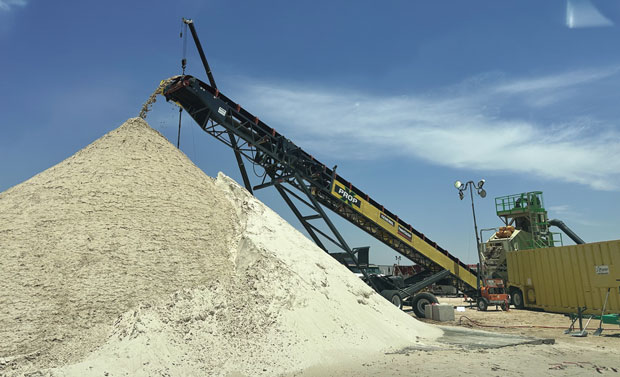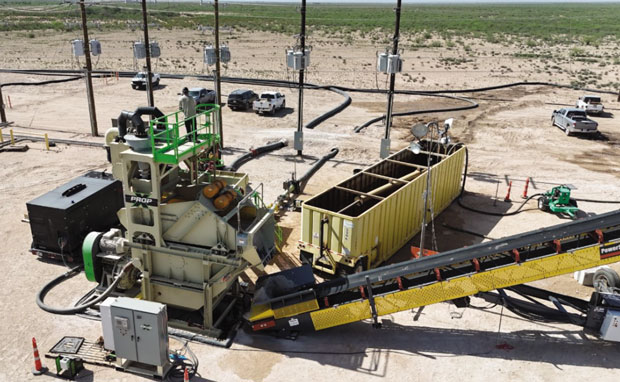
New Technique Gets Sand To Well Pads At Significantly Lower Cost
By Zach Mayo and Brian Dorfman
Well sites have long pulsed with the rumbling engines from the trucks traditionally required to deliver the massive quantities of sand that modern completion designs require. These vehicles get the job done, but they contribute to the top cause of recordable incidents: moving vehicles. Fortunately, a new sand transportation technology pumps that risk away. In its place: silence, safety, and a revolution in hydraulic fracturing efficiency.
For as long as the American shale revolution has existed, the industry has tirelessly driven toward better efficiency. As with everything in life, these incredible efficiency gains come with trade-offs. A modern simulfrac fleet requires upwards of a mind-blowing 200 truckloads a day of sand alone to feed the beast. That is a truckload every seven minutes. And with only hours of inventory on location, those trucks must keep coming 24 hours a day and seven days a week to prevent expensive downtime.
The relentless traffic has created a significant and growing challenge in safety and logistics. The exponential traffic growth also exposes lease roads and well pads to wear and tear well beyond what their designers envisioned, forcing operators to pay much higher maintenance and repair costs.
To accommodate sand and its carriers, well pads are getting larger. Even so, trucking is systematically and chronically operated ineffectively. And despite gargantuan efforts to minimize the amount of moving equipment on well sites, it continues to rise. A revolutionary sand transportation method solves not just a handful of these problems, but all of them in one simplified and sweeping change.
The New Approach
Instead of using trucks to carry sand from its source to its final destination, the method replaces wheels with water for the final leg of the journey. The sand arrives at the well site in a slurry that is transported by lay flat hose. The water and sand are separated, and the water returns to “pick up another load.”
This approach removes all well site traffic, preserves lease roads and shrinks pad sizes. At the same time, it expands on-site inventories and pushes reliable efficiency to new heights.
Called hydrohauling, the water-based method makes sense today partly because sourcing proppant has become a proximity game. In the Permian Basin in west Texas alone, there are more than 40 mines supplying proppant. Some of these locations sell wet sand, some sell dry sand, some sell both. Hydraulic fracturing equipment’s ability to run both types of sand on site provides operators with a tremendous cost advantage and unmatched flexibility to maneuver and retool their supply chains during disruptions.
In addition to improving uptime, that flexibility has helped wet/dry agnostic buyers reduce truck miles. The closer proppant is sourced to the well pad, the simpler last mile sand delivery becomes. With modern frac fleets pumping upward of 10 million pounds a day, normal inventory on site can shrink to barely enough to keep going for a few hours. To our knowledge, there is no other supply chain in the world that operates in such a challenging environment, with such tight tolerances and so little inventory on hand.
One of the factors that makes sand delivery challenging is how dramatically demand can seesaw from day to day. It is not uncommon for an operation to be humming along at 200-250 loads per day while pulling from a mine 65 miles away. Delivering those loads requires about 60 unique truck drivers. But the next day, a total shut down can occur, forcing those trucks to stop and sending disruptions throughout the entire last mile supply chain.
And the following day, operations can kick back up, restoring the need for 200-250 loads. Trucks can go from essential to idle to essential in the blink of an eye.
This unpredictability mandates a difficult balancing act, one that service companies perform day in, day out. Running out of proppant is unacceptable to the buyer and will earn the service company a one-way ticket back to the fence. The closer the source is to its destination, the lower the risk of downtime simply due to the exponential reductions in required drivers.
But even with proximity, there is always a possibility of something going awry. Whether we like it or not, the risk of wait time due to demand fluctuation is priced into the current proppant logistics model. That model is begging for change.
Proven Principles
No other supply chain as complex as the one for proppant operates in such an ad hoc fashion. From Amazon and FedEx to Southwest Airlines and Walmart, companies who need to move product quickly and reliably share a few commonalities. They utilize strategic staging, operate hubs and spokes, manage larger inventories as well as warehouse space, and track broad key performance indicators that focus attention on reducing “transport” wait time.
The oil field frequently operates at sufficient scale to adopt those best practices. In fact, they are already being applied. By using water pipes to transport sand across the final mile—or in many cases, directly from a mine that is within 10 miles of a frac site—companies can implement a new delivery strategy that significantly outperforms the status quo model in many scenarios.
A new sand delivery technique called “hydro hauling” transports sand to the well pad by mixing it with water and sending it through lay-flat hose. This eliminates the need to fill lease roads with trucks, improving safety and community relations while reducing environmental impacts and costs.
Here is how it is done: wet or dry sand is metered precisely into a slurry and pumped into a fit-for-purpose lay flat hose. Crews run this hose to the well site by following the right of way the exploration and production company has already acquired for water transfer.
Once the water arrives on site, it is separated and captured from the sand slurry and either pumped downhole with the frac or returned to the distribution center to carry another load. Sand is staged and stored in flexible volumes on site and can be run at a moment’s notice if the frac fleet ends up being more efficient than expected.
The slurry-based transportation eliminates truck traffic from the lease road. That significantly de-bottlenecks the delivery system, creates separation in the supply/demand dynamics and frees the well site from unnecessary moving equipment.
A Fantastic Use Case
Hydrohauling works brilliantly in areas with dense activity. Imagine an operator that plans to drill five multiwell pads within a few miles of each other. Once those wells are ready, the operator envisions completing the pads in quick succession, a task that will require about 12,000 loads of sand.
The operator does research and determines that sourcing dry sand from the prolific Kermit sand dunes of West Texas, which are about 55 miles away, offers the best economics. Fortunately, this operator has built centralized water storage facilities for the upcoming work and has robust rights of way all set and ready to go to each pad.
Instead of delivering all 12,000 loads to the five pads separately, this operator elects to implement hydrohauling. This begins with staging all loads on a pad that is right off the highway or main blacktop road, eliminating the need to send trucks on lease roads. The pad is between two and 10 miles from all five upcoming pads, allowing it to act as a sand distribution center.
All 12,000 loads head to that center for three months. Thanks to robust storage (both full and empty), it’s only necessary to send 140-160 loads to the location every day. No more, no less. This gives the trucking provider predictability and utilization, the two key elements needed to manage costs. It never has to send drivers on lease roads that beat up trucks and can create a reliable schedule for the drivers.
Such predictability has a huge impact on transportation economics. With a guaranteed delivery space at the distribution center, drivers will spend less time waiting and more time hauling. As a result, the trucking company will need ~30% fewer drivers than with the conventional method.
To move the sand from the distribution center to the well pad, a patented sump blender precisely meters the sand into water to create a three-pound-per-gallon slurry. A special lay flat hose carries this slurry across the water transfer right of way to the well pad. There, the sand is removed and stacked in a pile that remains damp.
Once the sand is on site, it is separated from the water and stored until it’s needed, at which point a loader transfers the sand from storage to the on-site metering system. The process is so streamlined that a single person can manage it.
The water is either stored on the pad and ready for frac to use or captured and returned to the distribution center through a return line that works the same way as the delivery line. When the frac calls for sand, a loader scoops a bucket into the damp sand pile and delivers it directly to the metering system on site, which is tied to the fracturing fleet and automated.
The result? A single person can keep sand moving on site. That means zero trucks on site, zero risk of truck wait/idle time, elimination of lease road destruction, happy surface owners and neighbors who no longer need to see or hear truck after truck driving across their land. Everyone wins.
An Even Better Scenario
Now imagine that the operator is drilling this same five-pad, multiwell package but happens to be within 10 miles of an infield mine. In this scenario, it’s no longer necessary to haul sand to the distribution center because the mine itself fills that role. All we need to do is run a temporary hose from the mine to each well site and set up equipment to separate sand and water, and the sand delivery system is ready to go.
In this scenario, the mine operates in a streamlined, efficient manner, with fewer personnel and no need for trucks. Driving is the most dangerous activity people do in the oil field, so minimizing it is the key to addressing some of the most persistent safety challenges in modern completions. Add in lower emissions and reduced wear and tear on roads, and the case for hydrohauling only gets stronger.
The last mile delivery method augments several past efficiency gains. The foundation was laid in 2017, when companies began building regional sand mines in West Texas to process sand in basin. This eliminated the need for the railroad to deliver sand from out of state, significantly reducing costs and cutting proppant lead times from weeks to hours.
In 2020, the industry figured out how to pump wet sand. Before, sand had to be dried through an energy-intensive process that required expensive equipment. Then that sand would be delivered to site, where it would of course get wet again. Taking away the drying step delivered major cost savings while definitively solving the silica dust exposure problem that frac crews previously faced.
Moisture-tolerant frac equipment meant sand providers could build smaller mines that only produced wet sand but could be placed “in-field,” right in the middle of operators’ acreage. Since 2021, more than 25 of these facilities have been opened in West Texas alone. They significantly reduce truck miles, providing operators with surety of supply and simplifying on-site sand management at a fraction of the cost once required.
As the industry has gained experience with wet sand, the systems for handling it have evolved. The newest equipment is more reliable than its predecessors and compatible with a wider range of moisture content.
In 2024, the industry retooled a stacking framework from the mining and aggregate industry to increase the amount of sand that could be stored on site in large piles. The simple, high-capacity storage technique has set the stage for simulfracs, and such sand-hungry operations will only get easier as hydrohauling spreads.
Hydrohauling is more than the next step forward. It’s a leap. By eliminating truck traffic from the well site and surrounding lease roads, the industry not only reduces the most common source of recordable incidents but also unlocks a new tier of efficiency that touches every part of the operation, from cost, safety, and surface impact to surety of supply, and most importantly, uptime.
The technique has already been proven in the field. It is a smarter, safer and more resilient last-mile model, and it is one the industry can adopt quickly. The tools for it already exist, the infrastructure is catching up, and the demand for predictability, flexibility and sustainability is louder than ever.

ZACH MAYO is the completions manager for Civitas Resources, which is based in Denver. Through roles at Civitas, Tap Rock Resources and Resolute Energy Corp., as well as the engineering firm LDIS, Mayo has spent more than a decade driving innovation and efficiency across many facets of the oil and gas industry, from completions to production and facilities. He holds a B.S. in mechanical engineering from the Rose-Hulman Institute of Technology.

BRIAN DORFMAN is the vice president of operations for PropX, a subsidiary of Liberty Energy that is based in Denver. He has more than a decade of experience driving innovation focused on the shale completions supply chain, during which time he has received several patents related to proppant delivery. Before co-founding PropX, Dorfman held various technical and sales roles at Halliburton. Dorfman earned a B.S. in finance and a B.S. in accounting from Georgetown University.
For other great articles about exploration, drilling, completions and production, subscribe to The American Oil & Gas Reporter and bookmark www.aogr.com.








